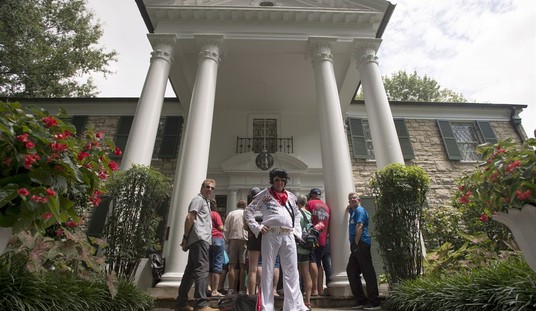With the Supreme Court hearing arguments in Janus v AFSCME this week, unions, liberals and much of the media (though I repeat myself) are really scrambling to pull out a win. Earlier today, Ed wrote about the efforts by some Democrats to shame the Supremes into not overturning a decades-old ruling based on stare decisis, but that’s not the only line of attack being mustered. Others, such as Daniel DiSalvo and Jeffrey Kucik at the Washington Post, are raising the specter of a looming fiscal crisis facing the entire nation if public sector unions aren’t allowed to continue deducting dues from non-members and spending that money to promote liberal policies.
The odd aspect of their analysis is that the authors are actually highlighting a very real problem currently bogging down state and local governments around the nation. (And one which will eventually begin to cripple the federal government as well absent any changes in policy.) They’re describing the huge, back-loaded costs of retirement plans for union workers which contain costs far above and beyond their basic pension payments, particularly their generous healthcare plans.
Such a ruling would weaken unions by reducing their revenue and limiting their bargaining power. But here is what has been going on under the radar. Janus could affect an important state government obligation: paying post-employment benefits other than pensions — primarily health-care coverage — to retired public workers.
As of 2016, these unfunded state government liabilities totaled $1.1 trillion nationwide. Stronger unions tend to push back when states try to reduce such benefits to balance their books. Weaker unions could enable states to relieve some fiscal stress.
The authors are correct in citing the cost of these retirement packages as a problem. It’s the primary driver which has nearly sunk New Jersey’s state government and embroiled Chris Christie throughout his entire tenure as governor. So one way to look at this (if you happen to be a liberal) is to say, as the authors do, that strong unions are able to push back against cuts to benefits.
Well, that’s a dandy solution if you happen to be one of the people receiving those benefits or planning your retirement around them. But it doesn’t do anything for the tens of millions of people in the private sector who have little chance of landing a job that offers anywhere near that level of retirement stability. It also does nothing to magically make more money appear in state and municipal budgets to cover these skyrocketing expenses. The authors attempt to claim that such expensive pension plans are justified because “many public-sector jobs offer lower salaries than their private-sector counterparts. As a result, public employees tend to have far more stable and secure retirements than similarly situated private-sector workers.”
No citation is offered for this incredible claim. If you look long and hard, you can probably find a handful of cases where it’s true, but for the most part and in nearly all cases, public sector workers earn more than their private-sector counterparts. And I did offer a linked citation for that. Perhaps even more embarrassingly, it’s from… The Washington Post.
What they should have been asking was why there was never anyone at the table arguing on behalf of the taxpayers when these labor agreements were originally crafted. But the authors go much further off the beam when they try to describe this as a problem which affects everyone equally and really shouldn’t be a left vs. right or Democrat vs. Republican issue. They attempt this feat in a couple of ways, arguing that Republicans receive union support also.
New York provides a useful example of the influence of public-sector unions. In 2015, a state Senate committee passed a bill to prevent state and local government employers from restructuring public employees’ future retirement benefits without first collectively bargaining with unions. The bill’s Republican sponsor hailed from Staten Island, where many police officers and firefighters live — and in 2016, received more than $60,000 in campaign contributions from public unions. That is three times the average given to other New York legislators, including Democrats, during the same cycle.
We see similar patterns nationwide. Republican legislators receive twice as much in labor contributions in states with strong public-employee unions ($91,000) than in states where such unions are weaker ($45,800). This money matters. In states where legislators receive greater contributions, retiree health-care liabilities are triple those in states where unions are weaker.
Yes, some Republicans do receive some union support and contribute to the unfunded liability problem. But notice that for their example they had to reference a pro-union bill in New York with at least one Republican sponsor. That’s a state senator from Long Island, by the way. First of all, speaking as someone who lives in the Empire State, you can find any number of people with an (R) after their name in state government who would be indistinguishable from a Democrat in most of the rest of the nation. Further, they’re talking about New York City which has been run by the unions (or in earlier days, the Mafia… or a combination of the two) for most of the nation’s history.
If you want a better look at how “balanced” things are in terms of union support for Democrats and Republicans, why don’t we just look at the entity being sued in this Supreme Court case? It’s the American Federation of State, County and Municipal Employees (AFSCME). How well do they spread their money around between the two parties? For that answer, we need look no further than Open Secrets to see what proportions of the more than $10M they spent in the 2015/2016 election cycle they spent where. Let’s take a peek at their outside money spent for or against candidates in those years, shall we?

Independent Expenditures: $8,340,618
For Democrats: $2,661,233
Against Democrats: $0
For Republicans: $0
Against Republicans: $7,562,498
Electioneering Communications: $0
Communication Costs: $1,883,204
Let’s see… the total spent for Democrats or against Republicans adds up to $10,223,731. And the amount spent for Republicans or against Democrats adds up to… hang on. Let me get my calculator out here. (carry the two…. six gozinta 14…) There we go. It adds up to zero. Zilch. Nada. In more technical terms found in post-graduate math classes, that’s known as bupkis.
So would you care to explain to me once more how this is an issue which hits both parties? I’m a bit slow and wasn’t really a math major so you may have to use small words.







Join the conversation as a VIP Member